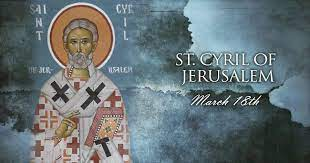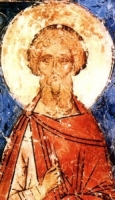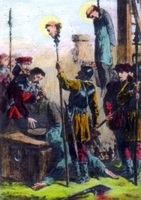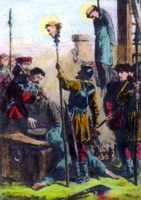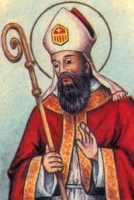St. Narcissus and Felix
Feastday: March 18
Martyrs. While it is certain that Narcissus, a bishop, and Felix, his deacon, were martyred in Spain, little else is known. Legends are associated with them, including their supposed escape to Germany or Switzerland.
St. Humphrey
Feastday: March 18
Death: 871
Benedictine bishop during the Norman invasion, also called Hunfrid. He was a monk at Prum until being made the bishop of Therouanne, France, in 856. Forced to flee the Normans, he returned to restore the city and to become abbot of St. Bertin in France.
St. Frediano
Feastday: March 18
Death: 588
Irish bishop, also called Frigidanus and Frigidian. He was reportedly a prince of Ireland who went on a pilgrimage to Rome and settled into a hermitage on Mount Pisano, near Lucca. The pope made him bishop of Lucca, but his see was attacked by Lombards. Frediano is believed to have founded a group of eremetical canons who merged with those of St. John Lateran in 1507.
Saint Cyril of Jerusalem
புனிதர் சிரில்
(St. Cyril of Jerusalem)
ஆயர்/ ஒப்புரவாளர்/ மறைவல்லுநர்:
(Bishop, Confessor and Doctor of the Church)
பிறப்பு: கி.பி. 313
ரோமானிய பாலஸ்தீனிய பிரதான நகரங்களில் ஒன்றான இஸ்ரேலின் மெடிட்டெரேனியன் கரையோரத்தில் உள்ள, “சீசரே மாரிடிமா” எனும் ஒரு பண்டைய துறைமுகம் அருகில், சிரியா பாலஸ்தீனம் (தற்போதைய இஸ்ரேல்)
(Possibly near “Caesarea Maritima”, an ancient port on the Mediterranean coast of Israel, one of the principal cities of Roman Palestine, Syria Palaestina (Modern-day Israel)
இறப்பு: கி.பி. 386 (வயது 73)
எருசலேம், சிரியா பாலஸ்தீனம்
(Jerusalem, Syria Palaestina)
ஏற்கும் சமயம்:
ரோமன் கத்தோலிக்க திருச்சபை
(Roman Catholic Church)
கிழக்கு மரபுவழி திருச்சபை
(Eastern Orthodox Church)
ஓரியண்டல் மரபுவழி திருச்சபை
(Oriental Orthodoxy)
ஆங்கிலிக்கன் சமூகம்
(Anglican Communion)
லூதரன் திருச்சபை
(Lutheran Church)
நினைவுத் திருநாள்: மார்ச் 18
தற்போதைய காலகட்டத்தில் திருச்சபைக்குள்ள நெருக்கடிகள் - அந்நாளைய நான்காம் நூற்றாண்டில் கிறிஸ்தவத்திற்கு எதிரான கொள்கைகளைக்கொண்ட ஆரியர்களால் (Arian heresy) திருச்சபைக்கு நேரிட்ட நெருக்கடிகளுக்கும் பயமுறுத்தல்களுக்கும் முன்னே மிகவும் சாதாரணமானதேயாகும். கிறிஸ்துவின் தெய்வீகத்தன்மையையே மறுதலித்த ஆரியர்கள் கிட்டத்தட்ட கிறிஸ்தவத்தை இல்லாது செய்தனர்.
புனிதர் சிரில், ஆரம்பகால திருச்சபையின் புகழ்பெற்ற இறையியலாளராக விளங்கினார். அனைத்துக் கிறிஸ்தவ திருச்சபைகளாலும் புனிதராக கொண்டாடப்பட்ட இவர், பாலஸ்தீனிய கிறிஸ்தவ சமூகத்தினரால் மிகவும் உயர்வாக மதிக்கப்பட்டவர். இவர், கி.பி. 1883ம் ஆண்டு, திருத்தந்தை பதின்மூன்றாம் லியோ (Pope Leo XIII) அவர்களால் திருச்சபையின் மறைவல்லுனர் என பிரகடணம் செய்விக்கப்பட்டார்.
"மாக்ஸிமசுக்குப் (Maximus) பின்னர் இவர் ஜெருசலேம் நகரின் ஆயராக பொறுப்பேற்றார். ஆனால், ஆரியனிச (Arians) ஆயர் "அகஸியஸ்" (Acacius of Caesarea) என்பவரது பகைமையாலும் பல்வேறு பேரரசர்களின் மாறுபட்ட கொள்கைகளாலும் இவர் ஒன்றுக்கும் மேற்பட்ட சந்தர்ப்பங்களில் நாடு கடத்தப்பட்டார்.
பாலஸ்தீன நகரில் அல்லது அதன் அருகாமையில் பிறந்த சிரில், சிறப்பாக கல்வி கற்றார். ஜெருசலேம் நகரின் ஆயர், புனிதர் "மகாரியஸ்" (St. Macarius of Jerusalem) அவர்களால் கி.பி. 335ம் ஆண்டு திருத்தொண்டராக அருட்பொழிவு செய்யப்பட்டார். சுமார் எட்டு ஆண்டுகளின் பின்னர் அருட்தந்தையாக அருட்பொழிவு செய்யப்பட்டார். கி.பி. சுமார் 350ம் ஆண்டின் பிற்பகுதியில் "மாக்ஸிமசுக்குப் (Maximus) பின்னர் ஜெருசலேம் நகரின் ஆயராக பொறுப்பேற்றார்.
அவர் ஜெருசலேமின் ஆயராகப் பொறுப்பேற்ற சூழ்நிலை பற்றி முரண்பட்ட தகவல்கள் உள்ளன. பிராந்திய ஆயர்களால் அவர் முறையாக அருட்பொழிவு செய்யப்பட்டார் எனவும், அதற்கு எதிராகவும் தகவல்கள் நிலவின. அவருக்கு எதிரான மற்றும் விரோதங்களைக்கொண்ட ஆரியனிச ஆயரான "அகஸியஸ்" சிரிலுக்கு எதிராக போர்க்கொடி தூக்கினான். ஜெருசலேம் திருச்சபையில் சிரிலுக்கு முக்கியத்துவம் அதிகரிப்பது கண்டு பொறாமை கொண்டான். ஜெருசலேம் கிறிஸ்தவர்களின் முக்கிய ஸ்தலமாகவும் யாத்திரை ஸ்தலமாகவும் மாறுவது கண்டு மென்மேலும் பொறாமை கொண்டான். தேவாலயங்களின் பொது சொத்துக்களை சிரில் விற்பதாக குற்றம் சாட்டினான். ஒருமுறை, ஜெருசலேம் நகரில் உணவுப் பற்றாக்குறையினால் பஞ்சம் ஏற்பட்டது. தமது மக்களுக்கு உணவுப்பொருட்களை வாங்குவதற்காக அவர் அங்ஙனம் செய்ததாக ஒரு நம்பிக்கை நிலவியது.
சிரில் மீதுள்ள குற்றங்களுக்கான விசாரணைக்காக "அகஸியஸ்" 'அழைப்பாணை' (Summons) அனுப்பினான். ஆனால், இரண்டு வருடம் வரை சிரில் அவற்றினை எதிர்த்தார். ஆனால், அகஸியஸின் செல்வாக்கின் காரணமாக கூடிய விசாரணை சபை, கி.பி. 357ம் ஆண்டு, சிரில் இல்லாத சமயம் பார்த்து அவரை பதவி இறக்கம் செய்தது. சிரில் "டாரஸ்" ஆயர் "சில்வானஸ்" (Silvanus) என்பவருடன் தஞ்சமடைந்தார்.
கி.பி. 359ம் ஆண்டு, சூழ்நிலைகள் அகஸியஸுக்கு எதிராக மாறின. அப்போது கூடிய "செலூஸியா" (Council of Seleucia) விசாரணை சபை, சிரிலின் ஆயர் பதவியை உறுதி செய்ததுடன், அகஸியசை பதிவியிறக்கம் செய்து தீர்ப்பளித்தது. இருப்பினும் 360ம் ஆண்டு, இத்தீர்ப்பு பேரரசன் "கான்ஸ்டன்ஷியசால்" (Emperor Constantius) மாற்றி எழுதப்பட்டது. சிரில் மீண்டும் தண்டனைக்குள்ளானார். ஜெருசலேமிலிருந்து நாடு கடத்தப்பட்டார். ஒரு வருடத்தின் பின்னர் பேரரசர் "ஜூலியன்" (Emperor Julian) இவரை நாடு திரும்ப அனுமதித்தார்.
கி.பி. 367ம் ஆண்டு, சிரில் மீண்டுமொருமுறை ஆரிய பேரரசன் "வலேன்ஸ்" (Arian Emperor Valens) என்பவரால் நாடு கடத்தப்பட்டார். மறு வருடம் கி.பி. 378ம் ஆண்டு, பேரரசன் "கிரேஷியன்" (Emperor Gratian) அவரை நாடு திரும்ப அனுமதித்தார். நாடு திரும்பிய அவர் மதங்களுக்கு எதிரான கொள்கைகள், பிளவு, கலவரம், குற்றங்கள் ஆகியவற்றால் ஜெருசலேம் சீர்குழைந்து போயிருப்பதைக் கண்டார். அவரது உதவிக்காக அனுப்பப்பட்ட புனிதர் கிரகோரி கூட (Saint Gregory of Nyssa) விரக்தியுற்று திரும்பினார். இருவரும் கி.பி. 381ம் ஆண்டு, நடந்த "கான்ஸ்டன்டினோபில்" சபையில் (Council of Constantinople) கலந்துகொள்ள சென்றனர். "நிசென்" ஒப்பந்தம் (Nicene Creed) பிரகடணப்படுத்தப்பட்டது. கிறிஸ்து, அதே பொருள் கொண்ட தந்தை என்று சிரில் ஏற்றுக்கொண்டார். சிலர் அதனை மனம் திரும்புதலின் நடவடிக்கை என விமரிசித்தனர். ஆனால், ஆயர் பேரவையோ ஆரியர்களுக்கெதிரான ஆச்சாரப் பணிகளின் வெற்றியாளர் என சிரிலை புகழ்ந்தனர்.
பின்னர், கி.பி. 386ம் ஆண்டு, அவர் மரிக்கும்வரை பிறர் தொந்தரவுகள் இல்லாதிருந்தார்.
Also known as
Cirillo, Kyrillos
Profile
Raised a Christian in Jerusalem. Well educated, especially in religion. Priest, ordained by Saint Maximus. A great teacher of catechumens, Cyril's instructions are still source documents for the Church's early teachings. Bishop of Jerusalem in 348. Exiled three times by the Arians, usually on some trumped up charge like selling church furniture, but actually on theological grounds. Attended the Council of Seleucia in 359. Attended the Council of Constantinople in 381. Greek Father of the Church. Doctor of the Church.
Born
315
Died
386 of natural causes
Saint Edward the Martyr
Also known as
Edward II
Additional Memorial
20 June (translation of relics)
Profile
Son of King Edgar the Peaceful, and ÆthelflÆd. On Edgar's death in 975, there was a disputed succession between Edward and his younger half-brother, Æthelred, Edgar's son by Ælfthryth, but Edward was chosen King of England at age 13; he reigned less than three years. Killed at the behest of his step-mother Elfrida so her son could take the throne, and popularly proclaimed a martyr.
Born
962
Died
• stabbed to death in the evening of 18 March 978 at Corfe Castle, Dorsetshire, England
• buried at Wareham, England
• relics translated to Shaftesbury Abbey on 13 February 981, and resided there for over 500 years
• relics hidden in 1539 when the abbey was seized by the state
• relics re-discovered in 1931 during an archeological dig on the site
• relics re-interred in the Brookwood Cemetery, Saint Edward the Martyr Orthodox Church, Woking, England under the care of monks in the Greek Orthodox tradition
Patronage
against glandular diseases
Saint Anselm of Lucca the Younger
Profile
Nephew of Pope Alexander II. Bishop of Lucca, Italy in 1073. Due to a dispute over imperial investiture, Anselm initially refused to accept the regalia of his office from Emperor Henry IV, but later gave in and accepted. He retired to lived as a Benedictine monk in a Cluniac monastery of Polirone in San Benedetto Po, Italy.
Recalled by Pope Gregory VII. Anselm's canons were slack in observance of the austere life, were placed under papal interdict and excommunicated, revolted, were supported by the emperor, and drove Anselm from his see in 1079.
Anselm retired to Canossa, Italy, as spiritual director of Countess Matilda of Tuscany, and then reformed the monasteries in her lands. Supported Pope Gregory VII's efforts to end lay investiture. Apostolic legate to Lombardy under Pope Victor III, again settling problems caused by the lay investiture conflict. Worked against the anti-pope Guibert of Ravenna. His prayers obtained the rout of the enemies of Gregory VII.
Born
1036 at Mantua, Italy
Died
• 18 March 1086 at Mantua, Italy of natural causes
• relics in the cathedral of Mantua
Patronage
Mantua, Italy
Representation
man standing in front of an army that is in confusion
Saint Frigidian of Lucca
Also known as
Erigdian, Finnian, Frediano, Fredianus, Fridian, Fridianus, Frigdianus, Frigianu, Frigidanus
Profile
Sometimes confused with Saint Finnian of Moville. Son of King Ultach of Ulster, Ireland. Educated in Irish monasteries. Priest. After a pilgrimage to Rome, Italy he settled as a hermit on Mount Pisano. Bishop of Lucca in 566, though he often left the city to spend days in prayer and solitude. Formed the clergy of his see into a community of canons regular. Rebuilt the cathedral in Lucca after it was burned by the Lombards.
The River Serchio frequently flooded the town of Lucca. Legend says that when the citizens called on Frigidian for aid, he asked for a rake or hoe, prayed over it, ordered the river to follow him, then dug new, safe course for the river by dragging the tool through the dirt.
Born
in Ireland
Died
18 March 588 of natural causes
Representation
• bishop hoeing a piece of ground
• bishop raking a piece of ground
• bishop with a crown at his feet
• changing the course of the River Serchio
• walking in procession as the Volto Santo crucifix is brought to Lucca on an ox cart
Blessed Aimée-Adèle le Bouteiller
Also known as
Amata Adele, Marta, Martha, Marthe
Profile
Third of four children of Andrea and Maria Francesca le Bouteiller Morel; the family were farmers and linen weavers, and her father died of tuberculosis when she was only 10 years old. Around age 20 she went to work as a maid. Aimee joined the Sisters of the Christian Schools of Mercy at the Abbey of Saint-Sauveur-le-Vicomte on 19 March 1841 and made her profession on 14 September 1842, taking the name Sister Martha; her novice mistress was Blessed Placide Viel. Martha worked in the kitchen, the fields, the wine cellar, caring for her sisters and guests at the house, serving 250 people a day during peace time, 500 a day during war, serving them drink and encouraging their faith. Legend says that her prayers insured that the cellars never ran dry.
Born
2 December 1816 in Percy, France as Aimée-Adèle
Died
Palm Sunday 18 March 1883 in Saint Sauveur-le-Vicomte Abbey in Normandy, France from a stroke
Beatified
4 November 1990 by Pope John Paul II
Saint Narcissus of Gerona
Also known as
• Narcissus of Ausburg
• Narcissus of Girona
• Narciso, Narcis
Profile
Born to he nobility. Priest, preacher and bishop of Gerona, Spain in the early 4th century. During the persecutions of Diocletian he fled to modern Augsburg, Germany with his deacon, Saint Felix of Gerona. There they befriended Saint Afra of Augsburg. Returning to Gerona, he and Felix were arrested and martyred.
Legend associates him with the miracle of the flies which led to some of his patronage topics and iconography. In 1286 the army of Philip II of Burgundy laid siege to the city of Gerona. When the troops tried to desecrate the tomb of Saint Narcissus, it broke open, a cloud of stinging flies emerged, chased the soldiers and caused to much havoc that the French troops fled, leaving the city in peace.
Died
• c.307 at Gerona, Catalonia, Spain
• relics in an urn in the San Narciso chapel in the church of San Felix in Gerona
Patronage
• against mosquitoes
• against stinging flies
• Augsburg, Germany
• Gerona, Spain
Saint Braulio of Saragossa
Also known as
Braulio
Additional Memorial
18 March (Spain)
Profile
Son of Gregory of Osma, a Hispano-Roman bishop. Monk at Saint Engratia's monastery, Zaragoza, Spain. Studied in Seville, Spain under Saint Isidore. Ordained in 624 by his brother John, archbhishop of Zaragoza. Archdeacon to John. Bishop in 631, and archbishop of Zaragoza. Noted scholar, writer, correspondent, and exceptional hagiographer. Advisor to kings of Spain. Fought Arianism, and converted the Visigoths from the heresy. Attended councils in Toledo in 633, 636 and 638. Collaborated with Saint Isidore to create his encyclopedic work, the Etymologies, which partially led Isidore to be proferred as the patron of computers and the Internet. His eyesight became extremely poor as he aged; we have letters in which he complained bitterly of the loss, as it put a stop to his studies.
Born
c.590
Died
• c.651 at Zaragoza, Spain of natural causes
• buried in the church of Nuestra Senora Merced del Pilar
Patronage
• Aragon, Spain
• University of Zaragoza
Saint Alexander of Jerusalem
Also known as
Alexander of Cappadocia
Profile
Studied in Alexandria, Egypt. Fellow student with Origen. Bishop of Cappadocia. Imprisoned from 204 to 211 for his faith during the persecutions of Severus. Pilgrim to Jerusalem upon his release. Coadjutor bishop of Jerusalem with Saint Narcissus in 212. Censured for encouraging Origen to teach in churches while still a laymen. Developed a large theological library. Imprisoned again during the persecutions of Decius. When given a chance to save himself by denouncing Christianity, he made a public pronouncement of his faith. He was thrown to wild animals, but they refused to attack him. Re-imprisoned, Alexander died in chains from general maltreatment. Martyr.
Died
martyred in 251 at Ceasarea
Blessed Celestine of the Mother of God
Also known as
• Celestina Donati
• Maria Anna Donati
• Marianna Donati
Profile
She early felt drawn to religious life. Founded the Congregation of the Daughters of the Poor of Saint Joseph Calasanzio (Calasanzian Sisters) in 1889 with a mission to teach the poor and the children of prisoners.
Born
26 October 1848 in Marradi, Florence, Italy as Maria Anna Donati
Died
18 March 1925 in Florence, Italy of natural causes
Beatified
• 30 March 2008 by Pope Benedict XVI
• recognition celebrated at the Cathedral of Florence, Italy, presided by Cardinal José Saraiva Martins
Saint Salvator of Horta
புனித_சால்வதோர் (1567-1938)
மார்ச் 18
இவர் (#StSalvatorOfHorta) ஸ்பெயின் நாட்டைச் சார்ந்தவர்.
மிகவும் எளிய குடும்பத்தில் பிறந்த இவர், சிறுவயதிலேயே தன் பெற்றோரை இழந்தார். இதனால் இவர் பார்சிலோனாவிற்குச் சென்று, செருப்புத் தைத்து அதிலிருந்து கிடைத்த சொற்ப வருமானத்தைக் கொண்டு வாழ்ந்து வந்தார்.
இவருக்கு இருபது வயது நடக்கும்போது பொதுநிலையினருக்கான பிரான்சிஸ்கன் மூன்றாம் சபையில் சேர்ந்து ஒரு துறவியைப் போன்று வாழ்ந்து வந்தார். அங்கு இவர் தனக்குக் கொடுக்கப்பட்ட மிகச் சாதாரண வேலைகளையும்கூட மிகத் தாழ்ச்சியோடு செய்து வந்தார்.
இவரால் பல அருமடையாளங்கள் நடந்தன. அதனால் இவரைச் சுற்றி எப்பொழுதும் நோயாளர்கள் இருந்தார்கள். இவர் வெறுங் காலோடு தான் எங்கும் சென்றார்; கடுமையான ஒறுத்தல் முயற்சிகளை மேற்கொண்டார். எனவே இவர் வாழ்ந்த காலத்திலேயே ஒரு புனிதராக அறியப்பட்டார்.
இவர் 1567 ஆம் ஆண்டு தனது 47 வயதில் இறையடி சேர்ந்தார். இவருக்கு 1938 ஆம் ஆண்டு திருத்தந்தை பதினொன்றாம் பயஸால் புனிதர் பட்டம் கொடுக்கப்பட்டது
Also known as
Salvador, Salvatore
Additional Memorial
17 April (Friars Minor)
Profile
Shepherd. Shoemaker. Franciscan lay brother at Barcelona, Spain. Cook, beggar and porter at the friary in the Horta-Guinardó area of Barcelona. Miracle worker and healer. His cell became a destination for sick pilgrims; said to have cured as many as 2,000 in a single day.
Born
1520 at Santa Columba, Gerona, Spain
Died
18 March 1567 at friary at Cagliari, Sardinia, Italy of natural causes
Canonized
17 April 1938 by Pope Pius XI
Video
YouTube PlayList
Blessed Christian O'Conarchy
Also known as
• Christianus
• Giolla Criost Ua Condoirche
Profile
Spritual student and archdeacon of Saint Malachy O'More at Armagh, Ireland. Received the Cistercian habit at Clairvaux, France in 1139 from Saint Bernard of Clairvaux. Abbot of the first Cistercian monastery in Ireland in 1142. Bishop of Lismore, Ireland in 1150. Papal legate for Ireland. In old age he retired to live as a prayerful monk at Odorney Abbey.
Born
c.1100 at Bangor, County Down, Ireland
Died
1186 at Odorney Abbey, Abbeydorney, Ireland of natural causes
Blessed John Thules
Additional Memorials
• 22 November as one of the Martyrs of England, Scotland, and Wales
• 29 October as one of the Martyrs of Douai
Profile
Priest of the apostolic vicariate of England, ministering to covert Catholics during the persecutions of James I. Martyr.
Born
c.1568 in Upholland, Lancashire, England
Died
18 March 1616 in Lancaster, Lancashire, England
Beatified
22 November 1987 by Pope John Paul II
Blessed Roger Wrenno
Also known as
Ruggero
Additional Memorial
22 November as one of the Martyrs of England, Scotland, and Wales
Profile
Layman of the apostolic vicariate of England, ministering to covert Catholics during the persecutions of James I. Martyr.
Born
c.1576 in Chorley, Lancashire, England
Died
18 March 1616 in Lancaster, Lancashire, England
Beatified
22 November 1987 by Pope John Paul II
Saint Eucarpius of Nicomedia
Profile
Pagan soldier in the imperial Roman army and stationed in Nicomedia (in modern Turkey). Assigned to hunt Christians during the persecutions of Diocletian, he came to know them and the faith so well that he converted. Martyr.
Died
burned alive in 304 at Nicomedia
Saint Trophimus of Nicomedia
Profile
Pagan soldier in the imperial Roman army and stationed in Nicomedia (in modern Turkey). Assigned to hunt Christians during the persecutions of Diocletian, he came to know them and the faith so well that he converted. Martyr.
Died
burned alive in 304 at Nicomedia
Martyrs of Nicomedia
Profile
Commemorates the Christians who were martyred anonymously, either singly and in small groups, by local pagans in the area of Nicomedia prior to the year 300, and who may have been over-looked in the waves of Diocletian persecutions that resulted in the deaths of thousands.
Saint Leobard of Tours
Also known as
Leopardo, Leobardo, Leobardus, Liberd
Profile
Spiritual student of Saint Gregory of Tours. Hermit for over 20 years near Marmoutier, France.
Died
593 of natural causes
Saint Egbert of Ripon
Profile
Monk at Ripon, England.
Died
• c.720
• relics in Ripon, England
Saint Felix of Gerona
Profile
Deacon. Martyr.
Died
c.307 in Gerona, Catalonia, Spain
Saint Finan of Aberdeen
Profile
Spritiual student of Saint Kentigern.
Died
595
